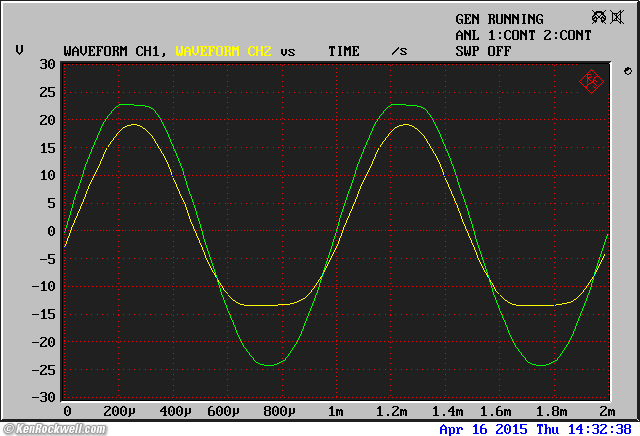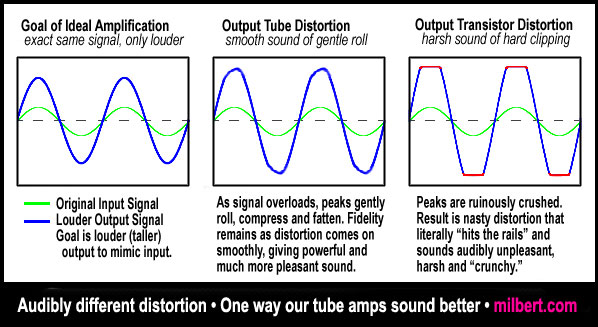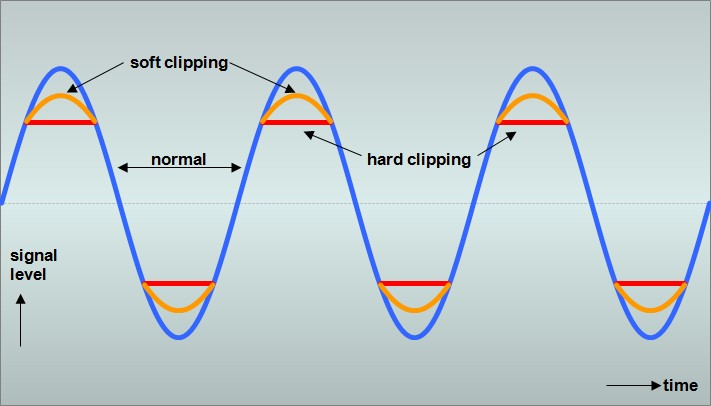NAD (New Acoustic Dimension) has a soft clipping option. Just more distortion I figure.Most manufacturers try to create clipping protections or soft-clipping inside their amps because clippings will induce DC into the speakers while putting lot of stress in the output stage and the power supply too. I would never test an amp when clipping, instead I'll try to put some markings on the volume knob when clipping starts occurring with 2V RMS at input and never try to pass volume knob below that mark.
Instead of testing amplifiers while they clip I suggest purchasing amps that have two times the output power of the speakers (audioholics guys and others suggest the same). This way we ensure that speakers will never see DC due to clipping and the amp will always provide a low THD+N. Of course, how everyone protects its speakers for overloading is another story.

McIntosh MC240 with old tubes clipping around at 25 watts per channel.
(Source: https://www.kenrockwell.com/audio/why-tubes-sound-better.htm)
"When a solid state amplifier clips, there is a sharp edge where it looks like someone simply took a pair of scissors to the tips of the waveforms. The sharp edges of solid state amplifier's waveforms at clipping give rise to insane levels of very high order ultrasonic harmonics, which are what blow out tweeters."
"The 'soft' characteristic (Green) shown in Figure 1 has few high order harmonics. The harmonic content is predominantly third harmonic, with a smaller amount of fifth, and lesser amounts of each additional higher odd-order harmonic. Because the waveform is symmetrical, even order harmonics are typically at vanishingly small amplitudes. Figure 2 shows the harmonic structure of each waveform. Note that 'hard' clipping produces high levels of eleventh, fifteenth and nineteenth harmonics compared to the soft clip circuit. However, both signals will sound objectionable with full range music and with the amount of clipping shown."
Figure 1 - Comparison of Transistor (Red) and Valve (Green) Clipping

Worth checking https://www.diyaudio.com/forums/ins...-powered-princeton-reverb-18.html#post5455791 as well.
L.E.:
-
Welcome to ASR. There are many reviews of audio hardware and expert members to help answer your questions. Click here to have your audio equipment measured for free!
- Forums
- Audio, Audio, Audio!
- Amplifiers, Phono preamp, and Analog Audio Review
- Stereo and Multichannel Amplifier Reviews
You are using an out of date browser. It may not display this or other websites correctly.
You should upgrade or use an alternative browser.
You should upgrade or use an alternative browser.
does it make sense to test how amps behave when they clip?
- Thread starter Sir Sanders Zingmore
- Start date
I had a very nice gift from a camcorder specialist. He gifted to me a pro video cam compound magnifying lens with excellent focal range and magnification. Those cost hundreds to buy from a specialist retailer/etailer. It could be disassembled into several pieces for service. Great lenses for SMD stuff and generally wanting to get right into it. One can really get into every nook and cranny upon inspection of both the PCB, the lenses and all the stuff otherwise.Same for me. It's quite a rapid deterioration of what was perfect closeup eyesight. Now, by necessity, I have plenty of lighting and illuminated large, articulated magnifiers.
Last edited:
I have to ask. What is your favorite analogue oscilloscope to use for general purpose?Thanks Ray. Us scope jockeys can spot a weird looking sine from 20 paces, but I'm no good with Photoshop, mirror images and all that.
The fact that the 20KHz looks fine could mean he was loading the signal generator with a non-linear load, adapter, meter or something and the amplifier was just amplifying it. It's unlikely it'd look like that at 1KHz and then be fine at 20KHz. It'll be a simple explanation.
I remember years ago chasing down something similar I could hear, and it turned out to be non-active (turned off) line inputs of connected tape decks presenting a non-linear (unbiased input junctions) load and distorting the waveform. Turn on the tape decks and it all went away. Next amplifier had switchable/defeatable record outs and buffered tape outs...
Even if he had two amplifiers hooked up to one source, but only one actually turned on, it could do that.
I like Class AB amps. Large power transformer, multistage decoupling, very compact layouts. Surface mount for bias and feedback. Minimal crossover distortion.
The regs for the input stage need high bandwidth and be able to supply excess currents. Plus be stable.
This is the start. With fine tuning the recovery from overload can be very fast. One key is filter capacitor size and impedance. Not excessive size and not too low an impedance. Too much filter capacitance slows down recovery. Too low impedance caps can to unstable conditions with large charging current.
No magic, solid engineering. Plus lots of testing.
After a while it gets easier. Then you can no longer see.
The regs for the input stage need high bandwidth and be able to supply excess currents. Plus be stable.
This is the start. With fine tuning the recovery from overload can be very fast. One key is filter capacitor size and impedance. Not excessive size and not too low an impedance. Too much filter capacitance slows down recovery. Too low impedance caps can to unstable conditions with large charging current.
No magic, solid engineering. Plus lots of testing.
After a while it gets easier. Then you can no longer see.
Ron Texas
Master Contributor
- Joined
- Jun 10, 2018
- Messages
- 6,654
- Likes
- 10,367
Absolutely. Albertans are our kindred spirits. It's the can do attitude.That's because everything is bigger in Texas(and Alberta) ;P
restorer-john
Grand Contributor
I have to ask. What is your favorite analogue oscilloscope to use for general purpose?
My trusty old CROs, one a Trio 60MHz CS-1060 and another 20MHz unit. I can operate them with my eyes closed as they've been on my bench for >30 years. My very first CRO was a Goldstar 20MHz unit that cost me $750 when I was a teenager. Even that still works although a bit dim.
I've had three DSOs over the years. Honestly don't like them much. Two are in the storeroom (an early couple of LCD TeKs). The Rigol 1054z I bought for fun and it is on my bench only because it's small, interfaces with my PC for screen-grabs and is really good at making you lazy with measurements. What I don't like about DSOs is their small depth- you can't put chit on top of them like you can with an old CRO.
If I was starting out, I'd give the same advice I was given 40 years ago. Buy a 20MHz minimum good quality CRO and learn how to use it. They cost virtually nothing these days 2nd hand. Get a nice Tektronix for <$200. Others will tell you to get a DSO. For audio work, I prefer a CRO, but DSOs can catch some amazing things. Get one of each and be done.
I'm very up to speed on a 7XXX series especially the 7603 model from Techtronics for a analogue and a Hewlett Packard 500 KHz analogue storage down to 2 MicroV/div c/w balanced input for audio work and low level viewing. Combine that with a Hewlett Packard balanced output oscillator and voila... That was the last bench I purchased plus metering, power supplies, lotsa hand tools and stuff, with some more stuff and lotsa smoky stuff and stuff... The last scope I purchased was a Fluke handheld 40MHz digital c/w a extended life battery for for field use and standard calibrated probes for higher voltage safety. Use a 100 MHz timebase and 250MHz vertical amplifier for added spec ;PMy trusty old CROs, one a Trio 60MHz CS-1060 and another 20MHz unit. I can operate them with my eyes closed as they've been on my bench for >30 years. My very first CRO was a Goldstar 20MHz unit that cost me $750 when I was a teenager. Even that still works although a bit dim.
I've had three DSOs over the years. Honestly don't like them much. Two are in the storeroom (an early couple of LCD TeKs). The Rigol 1054z I bought for fun and it is on my bench only because it's small, interfaces with my PC for screen-grabs and is really good at making you lazy with measurements. What I don't like about DSOs is their small depth- you can't put chit on top of them like you can with an old CRO.
If I was starting out, I'd give the same advice I was given 40 years ago. Buy a 20MHz minimum good quality CRO and learn how to use it. They cost virtually nothing these days 2nd hand. Get a nice Tektronix for <$200. Others will tell you to get a DSO. For audio work, I prefer a CRO, but DSOs can catch some amazing things. Get one of each and be done.
http://w140.com/tekwiki/wiki/File:7603-4trace.jpg
http://w140.com/tekwiki/wiki/7000-series_plug-ins
http://w140.com/tekwiki/wiki/7000-series_scopes
http://w140.com/tekwiki/wiki/File:Tek-7b53a-front.jpg
EDITED: Changed bandwidth of analogue storaqe scope to 500KHz from 500 MHz. OOps MY bad ¯_(ツ)_¯
Last edited:
I built a preamp circuit designed by PMA many years ago. Bipolar transistors, seems like it had degeneration. Worked great.
Thank you, it was probably this one:
http://pmacura.cz/dispre2_en.htm
http://pmacura.cz/step_sq_s.jpg
Add some beautiful VU meters while you're at itA clip indicator is something I have previously considered implementing. The Hypex modules all have the functionality built in.
Any words of wisdom from near death power? Can you feel it?I worked years with Tektronix 7603 and 7844. Tests of HV and VHV SF6 circuit breakers at rated currents up to 63kA ....
Any words of wisdom from near death power? Can you feel it?
You feel respect
I've heard about giving CPR to a high voltage high current victim(We call them victims in Canada.). It sounded pretty rough. Otherwise I busted a pair of glasses and gave myself a black eye when I took a respectably sized power supply across the forearm and hit myself across the upper face. I knew a guy that took a high powered magnetron and yelped loudly and wasn't himself for some days afterwards. >@^_*@< lolYou feel respect. And shaking ground when the power generator gets to the rated current value. Then another shaking when the breaker switches off, or once in a couple of years a horrible explosion, which, when it sometimes comes minutes after the test (accumulated pressure + temperature, melting contact metal hits the insulator = explosion) may be deadly, if you happen to be near.
A coworker touched 440 once.
It threw him back about 15 feet and he had nice burns from fingertip to above his elbow.
---
I cut myself on the same job... (machine shop)
Bled my name onto the floor (drip drip drip) standing in front of the empty First Aid cabinet.
Next day the the big boss (old retired US Steel engineer) came around, told me "Ray, next time you cut yourself bleed outside."
It threw him back about 15 feet and he had nice burns from fingertip to above his elbow.
---
I cut myself on the same job... (machine shop)
Bled my name onto the floor (drip drip drip) standing in front of the empty First Aid cabinet.
Next day the the big boss (old retired US Steel engineer) came around, told me "Ray, next time you cut yourself bleed outside."
Last edited:
I copped 240V hand-to -hand(across the heart) in an EE lab. when a student - adjusting frequency on a Wavetek sig. gen. (floating it seems) whilst holding a CRO(earthed).
Moved backwards, stunned, a few feet. Recovered and finished the experiment. Learned about "one hand in pocket" technique - no Thomas, not that one.
Only later, when studying electrocution, did I realise how fortunate I was. Scary, in those days, no one in the lab. was trained in resuscitation.
Moved backwards, stunned, a few feet. Recovered and finished the experiment. Learned about "one hand in pocket" technique - no Thomas, not that one.
Only later, when studying electrocution, did I realise how fortunate I was. Scary, in those days, no one in the lab. was trained in resuscitation.
Last edited:
We used the smoking with one hand while measuring with non-standard probes and leads in the other hand rule. Smoking a ciggy in the left hand was good and probing to the right was goodI copped 240V hand-to -hand(across the heart) in an EE lab. when a student - adjusting frequency on a Wavetek sig. gen. (floating it seems) whilst holding a CRO(earthed).
Moved backwards, stunned, a few feet. Recovered and finished the experiment. Learned about "one hand in pocket" technique - no Thomas, not that one.
Only later, when studying electrocution, did I realise how fortunate I was. Scary, in those days, no one in the lab. was trained in resuscitation.
restorer-john
Grand Contributor
I copped 240V hand-to -hand(across the heart)
I took the same hit only a few years ago when I discovered some faulty mains wiring in our meter box while checking circuit breakers after a power cut. Hand to hand and nobody else was home except me. Straight off the main feed from the meters themselves, with no ELCB in line. Was extremely lucky.
All due to a dodgy installation by the original electrician 25 years ago when the house was built.
House de Kris
Member
In an attempt to bring this thread back to clipping and not house wiring, I remember when a boss of mine asked "how cleanly does it clip?" when I was designing a Big Ass (BA) amp. I gave him a blank stare as I debated internally if I should delve into a diatribe on how clipping itself is not clean as it signals the onset of horrendous distortion. I thought better of that move, as I did understand the intent of the question, that I felt was oxi-moronic, and told him it was quite clean. It was paramount to be able to go into and out of clipping without oscillations, latchup, or modulations. Starting with a very robust power supply (with banks of BA caps) is a must, and each stage of the amp needs to be compensated appropriately. I cringe when I see some of the scope shots in this thread.
Much more recently I worked at a tube amp company. Made a big 300 watter. Its clipping behaviour was very similar to solid state, as in rounding was not visible at the clip. Then again, as much power supply capacitance as possible was stuffed into the chassis, and solid state rectifiers were used as opposed to hollow state.
My point? Some amps do clip gracefully.
Much more recently I worked at a tube amp company. Made a big 300 watter. Its clipping behaviour was very similar to solid state, as in rounding was not visible at the clip. Then again, as much power supply capacitance as possible was stuffed into the chassis, and solid state rectifiers were used as opposed to hollow state.
My point? Some amps do clip gracefully.
Tim Link
Major Contributor
I know very little about this topic but read a Sanders article that said most people don't know how much their amps are clipping. I borrowed an old analog osciloscope and hooked it up to my amp, which was attached to my speaker. Really didn't know what I was doing but finally started seeing the wave from the amp on the screen. I turned it up until the speaker was audibly distorting badly. The wave on the scope looked just fine as far as I could tell. I'm thinking he's talking about his speakers.
Last edited:
Similar threads
- Replies
- 4
- Views
- 670
- Replies
- 47
- Views
- 4K
- Replies
- 18
- Views
- 1K
- Replies
- 21
- Views
- 4K
